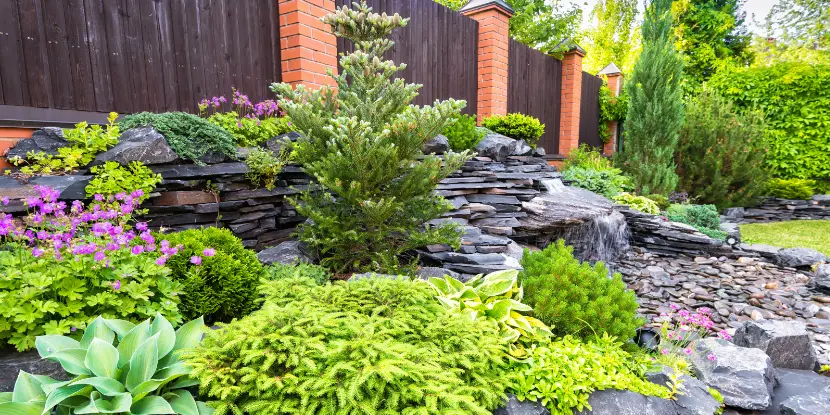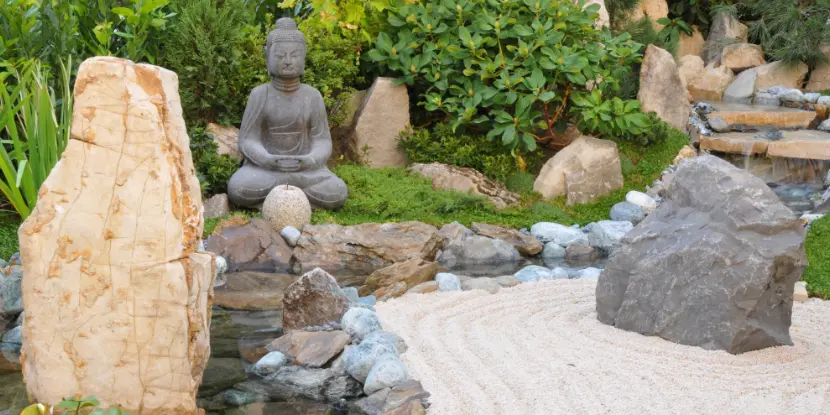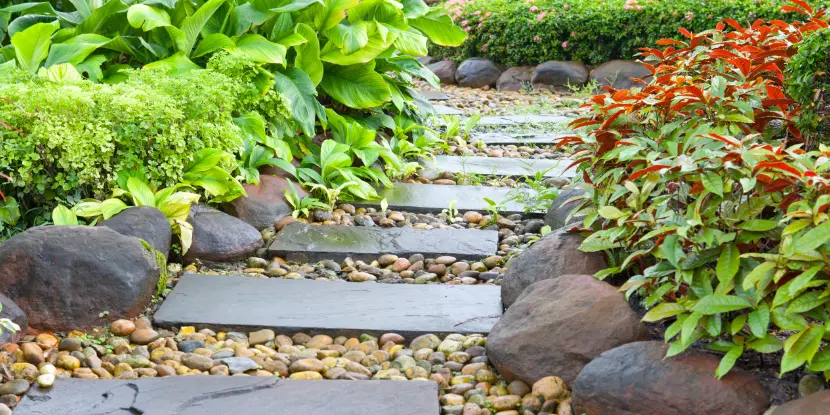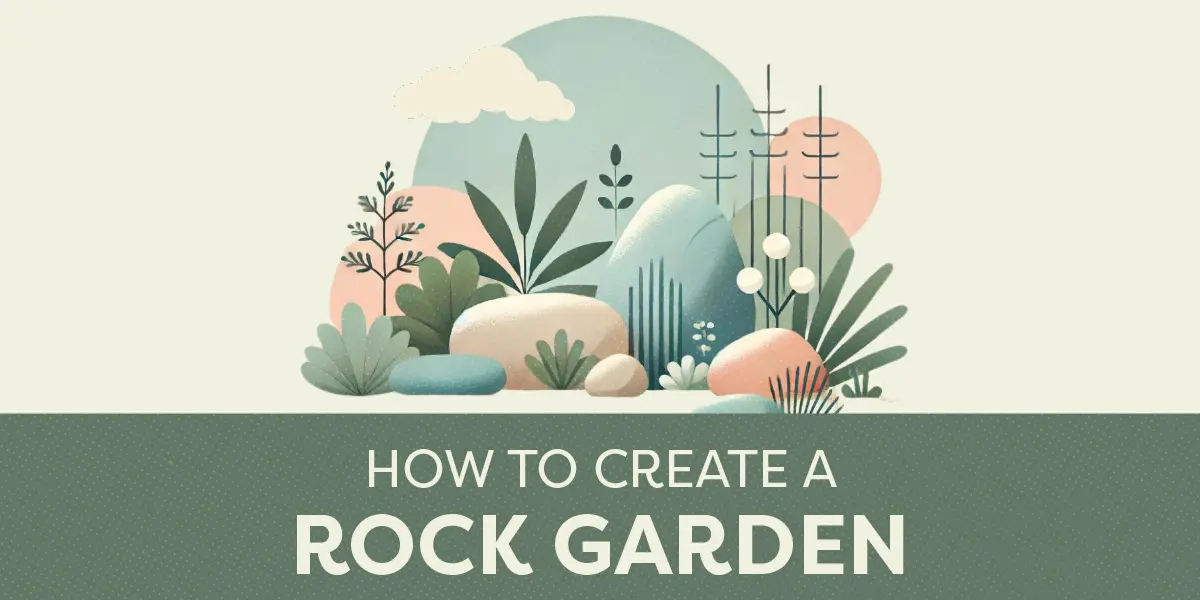Do you love nature but hate pushing a mower? Are you a wannabe artist, geologist, and maybe Zen monk?
Then rock gardening is for you! Just plant the rocks and watch them grow!
All kidding aside, a rock garden may be the very thing to put your soul at ease and build a stunning, low-maintenance, fire-resistant, and eco-friendly outdoor space.
What’s a Rock Garden?
A rock garden combines natural or artificial rocks and boulders with plants to create a pleasing landscape. It typically uses low-growing shrubs, succulents, and other small plants interspersed among the rocks to mimic an alpine or desert scene.

A rock garden covering a small portion of the yard.
Rock gardens can vary in size from a tabletop display to a large outdoor space that covers multiple levels. They’re increasingly popular for their easy maintenance and ability to thrive in harsh weather.
Benefits of a Rock Garden
There are plenty of reasons to fall in love with these rugged landscapes:
- Unlike traditional gardens, rock gardens don’t demand constant watering, weeding, or pruning.
- Rock gardens require little water and are perfect for drought-prone areas.
- Rock gardens can look fantastic year-round, even in the dead of winter.
- They’re eco-friendly, using natural materials and native plants.
- Rock gardens can be therapeutic. Gardening, especially in a natural setting, has calming effects.

A natural-looking alpine rock garden.
Planning Your Rock Garden
Assess Your Space
Before you start digging, consider the following:
- Location: Choose a sunny spot if you’re planning to grow succulents or alpine plants.
- Size: How big do you want your rock garden to be? Measure your space and start visualizing.
- Soil: Test your soil’s drainage. Rock gardens thrive in well-drained soil.

A beautifully designed tiered rock garden with slate.
Sketch Your Design
Grab a notebook and start sketching. This doesn’t have to be a professional blueprint, just a rough idea of where you want your rocks and plants to go. Think about:
- Rock Placement: Large rocks first, then fill in with smaller stones.
- Paths and Borders: Will you have walking paths or borders?
- Focal Points: Maybe a boulder or a small water feature?
- Plants: Choose plants that will flourish in your climate and complement your rock selection.
Building Your Rock Garden
Prepping the Ground
Clear the area of grass, weeds, or debris. If you’re dealing with poor soil, you might need to bring in sand or gravel to improve drainage. A good base layer is crucial for the success of your rock garden.

A classic desert-themed rock garden with cacti and succulents.
Placing the Rocks
Here’s where the fun starts (if you love hauling rocks)! Position the largest rocks first, burying roughly a third of each for an organic look. Arrange them in groups to duplicate how they might appear in nature. Fill in gaps with smaller rocks and gravel.
Planting
Dig small holes and position your plants with room to grow. Water them after planting, even if they’re drought-tolerant — new plants need extra TLC to get established.
Adding the Finishing Touches
Mulch & Gravel
Spread a layer of mulch, gravel, or small stones around your plants to help retain moisture and control weeds. This also gives your garden a polished look.

An organic-looking rock garden with succulents.
Decorative Elements
Decorative touches can include:
- Statues or sculptures
- Water features, like a pond, birdbath, or recycling fountain
- Solar-powered garden lights
- Benches or seating areas
- Outdoor art, like wind chimes or hanging lanterns
Maintaining Your Rock Garden
Rock gardens are low-maintenance. We didn’t say no-maintenance, and they’ll need a few things to look their best:
- Weeding: Hand-pull weeds and apply mulch or landscaping fabric to suppress them. Oscillating hoes work wonderfully well with gravel landscapes.
- Pruning: Trees, shrubs, and even flowers should be trimmed to shape plants and encourage new growth.
- Watering: Consider installing a drip irrigation system or self-watering containers.
- Adding New Plants: You may want to add vegetation or replace dead plants. Choose drought-tolerant and native plants for best results.
Inspiration: 10 Rock Garden Ideas for Southern California
1. Succulent Oasis
Combine different succulent varieties like echeveria, aloe, and agave. Succulents are easy to maintain and need minimal water.

A Zen-themed rock garden with raked gravel and sculptural elements.
2. Zen Rock Garden
Incorporate raked gravel, strategically placed boulders, and a few drought-tolerant plants to create a calming Zen-inspired garden. This design emphasizes tranquility and mindfulness, ideal for meditation.
3. Cactus Rock Garden
Mix various cacti, such as golden barrel, prickly pear, and beavertail, with rugged rocks and gravel. Cacti are some of the toughest and most drought-tolerant plants in nature.
4. Mediterranean Herb Garden
Integrate herbs like rosemary, thyme, and lavender with limestone rocks. These herbs thrive in hot, dry conditions and provide beautiful foliage and fragrant scents.

A spiral rock garden conserves space and water.
5. Native Plant Rock Garden
Use plants native to Southern California, such as California poppy, sagebrush, and yucca. Native plants are adapted to the local climate and soil and require fewer resources.
6. Water-Wise Garden
To conserve water, create a landscape with gravel, large boulders, and water-wise plants like kangaroo paws and lavender.
7. Contemporary Desert Garden
Combine modern design principles with natural elements: sleek, angular boulders, steel planters, and desert plants like Joshua trees and ocotillos for a chic yet natural aesthetic.

A rock garden with a pronounced alpine theme.
8. Alpine Rock Garden
For cooler coastal climates, try to replicate a mountain slope with rocks and alpine plants such as sedums, dwarf conifers, and artemisia.
9. Butterfly Rock Garden
Attract butterflies with drought-tolerant flowering plants like lantana, scabiosa, and milkweed interspersed among the rocks.
10. Shade-Tolerant Rock Garden
Combine shade-tolerant plants like ferns, hostas, and heucheras with smaller rocks and pebbles to mimic a lush, shaded woodland.

An elegant slate and rock pathway through a garden.
FAQs: Creating a Rock Garden
Q: What’s the best type of rock for a rock garden?
Granite, sandstone, and limestone are excellent choices due to their durability and natural appearance. For the best effect, choose various sizes.
Q: Can I build a rock garden in a small space?
Rock gardens can be scaled to fit almost any space, from a small corner of your yard to a larger landscape.
Q: How should I choose plants for my rock garden?
Opt for drought-tolerant species that thrive in rocky, dry conditions. Native plants are adapted to the local environment and require less maintenance. Mix different textures and colors for variety.
Q: How much maintenance does a rock garden require?
Expect regular weeding, pruning, and occasional watering and replanting as needed. However, compared to traditional gardens, rock gardens need much less upkeep.
Q: Do rock gardens attract pests?
Generally, no. Rock gardens are less vulnerable to pests than traditional gardens.
Q: How do I maintain the soil quality in a rock garden?
Start with well-draining soil. Add compost or organic matter annually to improve soil fertility. If you notice compaction, gently aerate the soil around your plants without disturbing the rocks.
Q: Can I include water features in my rock garden?
Small ponds, birdbaths, or recycling fountains can be a soothing element to your garden. Position them to complement the natural layout of your rocks and plants.
Q: How can I prevent weeds in my rock garden?
Weed barrier fabric under your rocks provides a strong defense against weeds. Regular mulching and hand-pulling also keeps them at bay.
Q: Can I create a rock garden on a slope?
Yes. Try building retaining walls with drainage for a terraced effect. This approach also allows for better water retention and soil conservation.
Q: What are some good companion plants for a rock garden?
Plants that complement each other in terms of growth habit and water needs work best. For example, succulents pair well with low-growing ground covers like thyme and sedum. Combining grasses and perennial flowers can also create a balanced look.
Q: How can I make my rock garden kid-friendly?
Select sturdy, non-toxic plants and provide clear paths through the garden. Avoid plants with sharp thorns or leaves, and incorporate interactive elements like stepping stones or small sculptures that children can enjoy.
Q: Can I add seasonal interest to my rock garden?
A mix of evergreen and deciduous plants will ensure year-round interest, such as daffodils and irises for spring color and autumn-flowering perennials to extend the garden’s appeal into fall.

